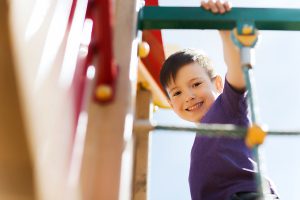Premise Liability: Playgrounds
 Michael Babboni
Premises Liability
Playgrounds are supposed to be place of fun and excitement where children can make new friends and get out all of their pent up energy. However, they also can present risks and hidden dangers as well. According to the Centers for Disease Control and Prevention, each year hospital emergency rooms treat more than 200,00 children age fourteen and younger for playground-related injuries. Of those playground injuries, the vast majority occur at schools and day care facilities.
Michael Babboni
Premises Liability
Playgrounds are supposed to be place of fun and excitement where children can make new friends and get out all of their pent up energy. However, they also can present risks and hidden dangers as well. According to the Centers for Disease Control and Prevention, each year hospital emergency rooms treat more than 200,00 children age fourteen and younger for playground-related injuries. Of those playground injuries, the vast majority occur at schools and day care facilities.Sadly, injuries to children at playgrounds can often be severe. It is estimated that playgrounds have a higher rate for severe injuries than bicycle accidents and even automobile accidents. This is due to a number of factors such as the certain types of activities and equipment that can be often be found on the playground.
For example, playing on the monkey bars puts children at a great height with little to no protect underneath them and the ability to climb, swing, and even get stuck in the bars themselves.
The most common types of playground injuries include:
- bruises
- broken or fractured bones
- concussions or other head injuries
- dislocations
- internal injuries
Common Causes of Playground Injuries
Any number of factors can play a role in causing playground injuries, but there are a few causes that are more common than others.
Poor Maintenance or Design of Playground Equipment
In many areas, playground equipment is often quite old. Decades old in fact. Over the years, significant deterioration of equipment can occur depending on the construction materials used.
For example:
- Metal components can rust or fatigue
- Screws and bolts come loose
- Wood rots and deteriorates
It is due to those factors and more that playground equipment be regularly inspected and maintained to ensure everyone’s safety. However, proper design of the playground and its equipment is also very important.
For example, a regular risk inherent in any playground is that children will fall, whether from the equipment or merely while running across the ground. The presence of a soft falling surface, as with other design elements, is an important aspect of a safe playground.
Lack of Adequate Supervision
One of the most important factors in preventing playground injuries is the regular observation and supervision of the children.
At a young age, children are often unaware of their own limitations. They rarely have the necessary experience to appreciate the risks that come with running too fast or climbing too high. Because of that, adequate adult supervision is an integral part of providing children a safe environment while on the playground.
The level of supervision required depends on various factors, including the age of the children and the level of risk associated with any particular playground activity.
Who is Liable for Playground Injuries?
Identifying the persons or entities responsible for a child’s injury on a playground will depend mostly on the answer to two questions:
1. Who owns the playground?
Knowing who owned the playground is crucial to knowing who is responsible for maintenance of the equipment and sometimes who was responsible for supervising the children. Here are just a few examples of playground liability:
- If the playground is at a public park, the entity responsible for its maintenance is probably the local municipality, meaning the town, the city, or even the county. The federal government typically maintains playgrounds at national parks.
- Playgrounds at schools however, are usually owned and maintained by the public school district.
- In the case of a private school or day care facility, typically a church or other not-for-profit entity owns the playground.
- A national restaurant chain or a local franchising company often owns playgrounds at restaurants.
2. Who designed and built the playground?
Playgrounds are rarely designed or constructed by the person or organization that ultimately owns the property on which the playground sits. Even in the case of a town or a school, the design and construction of a playground is usually contracted out to a local construction company. The construction company often hires other companies to design the playground or provide the components and materials for the equipment.
Depending on the cause of a child’s injury on the playground, the actions of any of those organizations might have played a role in causing the injury if the design or construction of the equipment was a factor.
